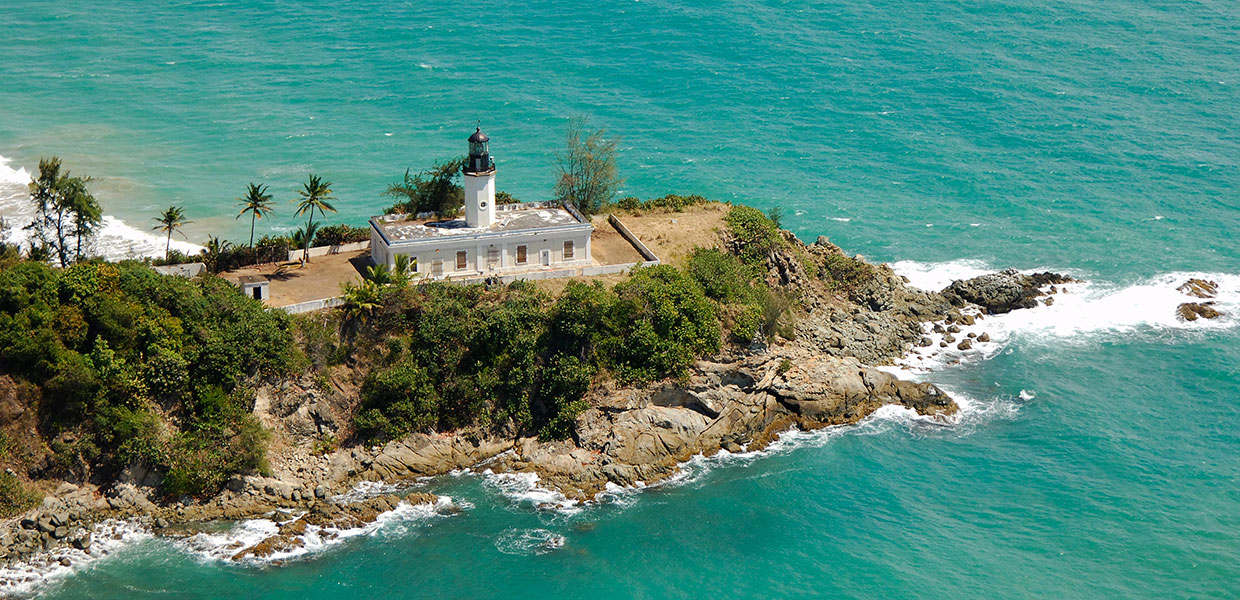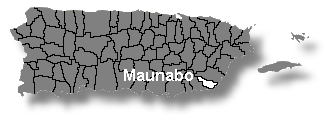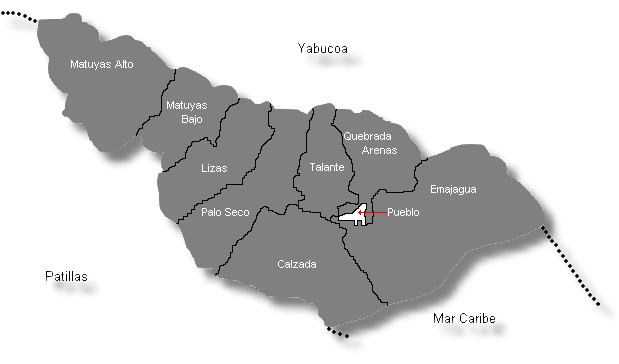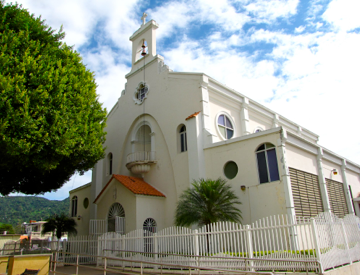
Maunabo, Puerto Rico
The Calm City

Maunabo (mou-NAH-bo) is known as the “land crab town”, “the town of the land crab eaters”, and “the calm city”. The patron saint is Saint Isidore the Farmer, whose festival is celebrated on May 15.
Maunabo is located on the southeast coast, southeast corner of Puerto Rico. It is bordered on the north and northeast by Yabucoa, on the southeast by Patillas, and on the east south east by the Caribbean Sea. There are three regions in the municipality: the Maunabo valley in the south central area, the semiarid hills to the south, and the mountainous region to the east. The town is part of the semiarid hills of the South.
The Maunabo coast runs from Point Toro on the northeast near Yabucoa to the southwest at Cape Cabo Mala Pascua on the border with Patillas. The old Spanish lighthouse is located midway along the coast at Point Tuna.
The town`s economy is based on truck farming, cattle, fishing, and some manufacturing. A tunnel is currently being built to make the town more accessible.
Foundation:
Maunabo was founded in 1779, according to historian Cayetano Coll y Toste. The origin of its name is related to Chief Manatuabón (although there are discrepancies about the existence of this chief) and the Manatuabón River, many times mistaken for the Grande de Manatí River. Maunabo’s first settlers were from neighboring Guayama that, once the Caribe Indians and the pirates disappeared, the settlement of this coastal region was initiated.
The parish of this municipality was organized in 1799 under the avocation of San Isidro Labrador. During the first decades of the last century the construction of the town had taken place already. The King’s House was concluded in 1825. Three years later Majagua, Palo Seco, Quebrada Arenas and Talante wards integrated the municipality. The Majagua ward takes its name from the “emajagua” tree with an archaism, since this word was no longer used, except in Cuba and other Hispano-American countries. During this period, the economy was based on the cultivation of coffee, tobacco, rice and fruits and sugar cane in a smaller scale. The population had surpassed 1,500 inhabitants.
Navigation was blooming in the Maunabo seas; in 1892 the Punta Tuna lighthouse was erected. On August 8, 1899 the population and the municipality underwent the fury of hurricane San Ciriaco, destroying almost all the houses and demolishing “La Bordalez” sugar refinery. The Columbia sugar refinery was built in 1901, that would be for many years a source of employment of first order.
In 1902 the Legislative Assembly of Puerto Rico approved the Law for the Consolidation of certain Municipal Terms by which the municipality of Maunabo was eliminated, transferring its civil servants and wards to Yabucoa. This situation remained until 1905, when a new law countermanded the previous one and restituted Maunabo to its condition of municipality, with the wards it had had in 1902. In 1928 hurricane San Felipe destroyed almost all the houses of the population, the Columbia sugar refinery, the catholic and protestant churches, and ruined in great part the agricultural wealth of the municipality.
Location:
 Manaubo is located in the southeastern end of Puerto Rico. Bordering it are: Yabucoa to the north; Patillas and the Caribbean Sea to the south; again the Caribbean Sea to the east; and Patillas to the west.
Manaubo is located in the southeastern end of Puerto Rico. Bordering it are: Yabucoa to the north; Patillas and the Caribbean Sea to the south; again the Caribbean Sea to the east; and Patillas to the west.
Area:
54.0 sq km / 21.0 sq mi
Population:
12,741 (censo 2000)
Population Density:
235.9 per sq km / 606.7 per sq mi
People are known as:
Maunabeño
Maunabo is also known as:
La Ciudad Tranquila (The Calm City)
Los Jueyeros (The Crabs)
Los Come Jueyes (The Crab Eaters)
Wards: Maunabo, Puerto Rico

| Census 2000: Population by Wards – Maunabo |
Habitants |
| Calzada | 1,262 |
| Emajagua | 4,515 |
| Lizas | 834 |
| Matuyas Alto | 413 |
| Matuyas Bajo | 274 |
| Maunabo Town | 395 |
| Palo Seco | 1,849 |
| Quebrada Arenas | 2,060 |
| Talante | 1,139 |
| Total | 12,741 |
Source: Censo 2000
Patron:
San Isidro Labrador
San Isidro Labrador Parish
Apartado 248
Maunabo, P.R. 00707
(787) 861-2595

Topography:
The limits of the Pandura Sierra run thru the north and the northeast region of this municipality, in which the Pandura and El Sombrerito hills, at the border with Yabucoa, are the highest elevations. With the exception of the before mentioned elevations, the rest of the territory of Maunabo is quite level. It’s for this reason that geographically it is considered part of the Southern Coastal Valley.
Hydrography:
It is bathed by the Maunabo, Lachi rivers and several gorges, among them, the Coroco, De los Chinos, Tumbada, Talante, Arenas and the Emajagua. This last one is born in the ward of the same name; short in lenght that ends directly to the sea.
Climate:
The average of rain for the municipality of Maunabo is around 80 inches per year, although there have been years in which only 3 inches have fallen. The average temperature is 78 degrees with a low of 68 degrees and a high of 88 degrees.
Economy:
Agriculture (cattle & vegetables) and fishing.
Average Salary:
$263.00 weekly (1998)
Flag:
 Maunabo’s flag is composed of a green cloth crossed diagonally by a white stripe. In each corner of the two remaining green triangles, there are two yellow ox yokes. The ox yokes, as emblems of agriculture, represent San Isidro Labrador patron of Maunabo.
Maunabo’s flag is composed of a green cloth crossed diagonally by a white stripe. In each corner of the two remaining green triangles, there are two yellow ox yokes. The ox yokes, as emblems of agriculture, represent San Isidro Labrador patron of Maunabo.
Coat Of Arms:
 In a silver field, an inverted green “V”, the upper portion also in green, with a silver lighthouse (a schematic and conventional representation of the lighthouse building of Maunabo) and two gold yokes lined in silver to its side. Toped with a silver three tower crown mural, outlined in black with green openings.
In a silver field, an inverted green “V”, the upper portion also in green, with a silver lighthouse (a schematic and conventional representation of the lighthouse building of Maunabo) and two gold yokes lined in silver to its side. Toped with a silver three tower crown mural, outlined in black with green openings.
The main colors of the shield, silver and green, the colors of sugar cane in bloom, symbolize the main source of wealth of Maunabo since its foundation. The inverted “V” represent the two sierras, that protect the town of Maunabo; The Guardarraya Sierra and the Pandura Sierra. And finally, the ox yokes, as emblems of agriculture, symbolize San Isidro Labrador, patron of Maunabo.
Events:
- Gifts on the eve of Three Kings’ Day – January
- Patron Saint`s Festival – May
- Isidore, the Farmer Community Festival – May
- Town Festival – June/July
- Festival of Our Lady of Mount Carmel – July
- Night Out – August
- Land Crab Festival and Carnival – September
- Christmas party at Calle 3 (Palo Seco) – December
- Aníbal Arroyo Cup (basketball event) – December
- End of Year Marathon – December
Places To Visit:
- Maunabo Cultural Center
- Indian Cave
- La Cantera Caves
- Point Tuna Lighthouse
- Saint Isidore, the Farmer Labrador
- The Written Rock
- Town square
- Central Columbia ruins
Beaches:
Distinguished Citizens:
- Luis Riefkhol – administrator of Hacienda La Bordaleza
- Benjamín Ortiz Ortiz – attorney, House Representative at large and for districts 5 and 6 (1945 – 1952 and 1961 – 1968) ; professor.
- Cruz Ortiz Stella – attorney, poet, House Representative for District 31 (1941 – 1944), and senator for Districts 7 and 8 (1945 – 1969).
Public Schools sorted by educational levels.
Maunabo District
| Name | Level | Telephone | Address |
| CALZADA | ELEMENTAL | (787) 861-3274 | PO BOX 1079 |
| ELEMENTAL URBANA | ELEMENTAL | (787) 861-5140 | PO BOX 38 |
| MATUYAS BAJO | ELEMENTAL | (787) 861-0456 | PO BOX 1023 |
| ALFONSO CASTA MARTÍNEZ | INTERMEDIO | (787) 861-3500 | PO BOX 38 |
| HIGINIO FIGUEROA VILLEGAS | SEGUNDA UNIDAD | (787) 861-2340 | HC 1 BOX 7000 |
| MANUEL ORTIZ SUYA | SEGUNDA UNIDAD | (787) 861-4600 | PO BOX 38 |
| ALFONSO CASTA MARTÍNEZ | SUPERIOR | (787) 861-2300 | PO BOX 38 |
Hymn:
By Gilberto Martorell Hernández
Maunabo pueblito del sureste de mi amada patria Borinquén
Tus lunas llenas, y tu sol tus blancas nubes,
su arrebol eres Maunabo, un mismo Edén.
Tus palmeras abanican y saludan lisonjeras
al obrero o al viajero el paisaje brindarán.
Tus llanos verdes….que primor tu Mar Caribe….
que explendor al ser inspiran amar al Creador.
A ti Maunabo, cantaremos con el alma y emoción
y te amaremos con el corazón.

